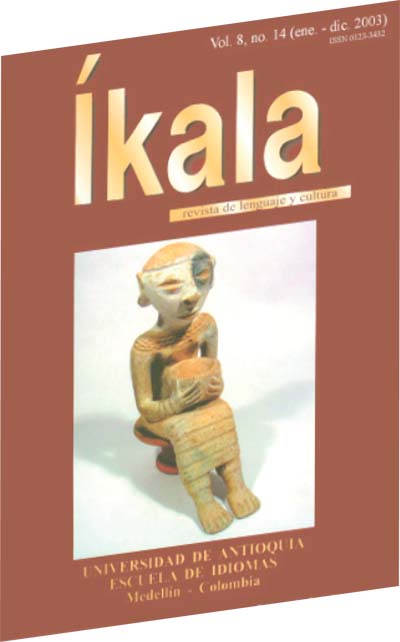Creating hypertexts. A strategy to foster writing
DOI:
https://doi.org/10.17533/udea.ikala.3179Keywords:
hypertext, hypermedia, multimedia, writing in first and second language, teacher educationAbstract
The purpose of this publication is to share an experience of teacher education and research with Colombian teachers of English using hypertext as a strategy to promote creative writing in Spanish as their native language and in English as their foreign language. This exploratory study was part of the interdisciplinary work developed with graduate students of the Masters program in Applied Linguistics in the seminar on Applications of Hypermedia materials in first and second language. The teacher researchers implemented the writing strategy with children and young adults in elementary, secondary and higher education programs. The article also presents a description of how data was collected and analyzed in the creation of hypertexts with students participants.
Received 24-04-03 / Accepted: 18-07-03
How to reference this article:
Clavijo Olarte, A. & Quintana Ramírez, A. (2003). Creación de hiperhistorias: una estrategia para promover la escritura. Íkala. 8(1), pp. 59 – 78
Downloads
References
Austin, Teresa, 2001, “Integrating technology in an interactive classroom”, Chapter in progress.
Ballesteros, Blessed y Antonio Quintana, 1998, “El periódico electrónico hipermedial”, Educación y Cultura, (44), Bogotá.
Barret, E., comp., 1995, Medios contextuales en la práctica cultural, Barcelona, Paidós.
Barthes, Roland, 1980, S/Z, Madrid, Siglo XXI.
Borges, J., 1999, “El jardín de los caminos que se bifurcan”, en: Ficciones, Madrid, Alianza.
Borba, Campos Marcia de, 1996, “O uso de hiperhistorias no desenvolvimento psicomotor de crianças”, en: Red Iberoamericana de Informática Educativa (RIBIE), Memorias, Tercer congreso iberoamericano de informática educativa, Barranquilla, Colombia.
Cortazar, Julio, 1998, Rayuela, Bogotá, Editorial Panamericana.
Esquivel, Laura, 1995, La ley del amor, México, Grijalbo.
Fiderio, Janeth, 1988, “A grand vision”, Byte, Massachusset, october, pp. 237-245.
Flower, Linda y John Hayes, 1981, “A cognitive Process. Theory of Writing”, en: College composition and communication, Illinois.
Freinet, Celestin, 1974, El diario escolar, Barcelona, Editorial Laia.
Henao Álvarez, Octavio, 2002, Procesamiento cognitivo y comprensión de textos en formato hipermedial, Medellín, Editorial Universidad de Antioquia.
Landow P., George, 1995, Hipertexto: la convergencia entre la teoría crítica contemporánea y la tecnología, Barcelona, Paidós.
Liu, M. y S. Pedersen, 1998, “The effect of beign hypermedia designers on elementary school student´s motivation and learning of design knowledge”, Journal of Educational Multimedia and Hypermedia, 9 (2).
Nelson, Theodor H., 1988, “Managing Immense Storage. Project Xanadu provides a model for the possible future of mass storage”, Byte, Massachusset, pp. 225- 238.
Ong, Walter, 1994, Oralidad y escritura, Bogotá, Fondo de Cultura Económica.
Palumbo, D. y D. Prater, 1993, “The role of hypermedia in systhesis writing”. Computers and Composition, 10 (2), pp. 59-70.
Quintana, Antonio, 2001, “De la palabra artesana al texto hipermedial”, en: Memorias Segundo congreso colombiano de lectoescritura en lengua materna y lengua extranjera, Bogotá, Universidad Distrital Francisco José de Caldas.
Quintana, Antonio y Amparo Clavijo, 2002, Programa curricular del seminario Adapting Hypertext and Hypermedia materials for L1 and L2, Bogota, Universidad Distrital, Maestría en Lingüística aplicada a la Enseñanza del Inglés.
Red Iberoamericana de Informática Educativa (RIBIE), 1996, Memorias, Tercer congreso iberoamericano de informática educativa, Barranquilla, Colombia.
Rodari, Gianni, 1999, Gramática de la fantasía, Bogotá, Editorial Panamericana.
Rodríguez Ruiz, Jaime Alejandro, 1999, Hipertexto y literatura, Bogotá, Pontificia Universidad Javeriana.
Rueda, Rocío y Antonio Quintana, 2002, “Ambientes educativos hipertextuales:
modelos de uso en procesos de enseñanza aprendizaje”, Revista científica, (4), Bogota, Universidad Distrital Francisco José de Caldas.
Sánchez, Jaime, 1996, “Análisis de una metodología para construir hiperhistorias”, en: Red Iberoamericana de Informática Educativa (RIBIE), Memorias, Tercer congreso iberoamericano de informática educativa, Barranquilla, Colombia.
Sánchez Jaime y otros, 1996, “Hiper-historias para hiper-aprender”, en: Red Iberoamericana de Informática Educativa (RIBIE), Memorias, Tercer congreso iberoamericano de informática educativa, Barranquilla, Colombia.
Sigmar-Olaf, T., 1997, “Múltiple Views, contexts, and symbol systems in learning with hypertext/hypermedia: a critical review of research”, Educational Technology, 37 (4), pp. 5-18.
Swan, K. y C. Meskill, 1996, ”Using hypermedia in response-based literature classrooms: A critical review of comercial applications”, Journal or Research on Computing Education, 29 (2), pp. 167-195.
Thraves, Stephen, 1994, La isla de los fantasmas, Barcelona, Grupo editorial CEAC S.A. Timun Mas.
Yang, S., 1996, “A dynamic reading-linking-to-writing model for problem solving within a constructive hypermedia learning environment”, Journal of Educational Multimedia and Hypermedia, 5 (3-4), pp. 283-302.
Downloads
Published
How to Cite
Issue
Section
License
Copyright (c) 2003 Íkala, Revista de Lenguaje y Cultura

This work is licensed under a Creative Commons Attribution-NonCommercial-ShareAlike 4.0 International License.












